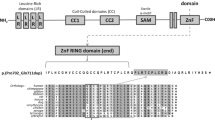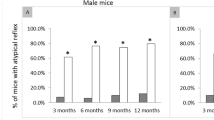Abstract
Charcot-Marie-Tooth disease type 2C (CMT2C) is an autosomal dominant neuropathy characterized by limb, diaphragm and laryngeal muscle weakness. Two unrelated families with CMT2C showed significant linkage to chromosome 12q24.11. We sequenced all genes in this region and identified two heterozygous missense mutations in the TRPV4 gene, C805T and G806A, resulting in the amino acid substitutions R269C and R269H. TRPV4 is a well-known member of the TRP superfamily of cation channels. In TRPV4-transfected cells, the CMT2C mutations caused marked cellular toxicity and increased constitutive and activated channel currents. Mutations in TRPV4 were previously associated with skeletal dysplasias. Our findings indicate that TRPV4 mutations can also cause a degenerative disorder of the peripheral nerves. The CMT2C-associated mutations lie in a distinct region of the TRPV4 ankyrin repeats, suggesting that this phenotypic variability may be due to differential effects on regulatory protein-protein interactions.
This is a preview of subscription content, access via your institution
Access options
Subscribe to this journal
Receive 12 print issues and online access
$209.00 per year
only $17.42 per issue
Buy this article
- Purchase on Springer Link
- Instant access to full article PDF
Prices may be subject to local taxes which are calculated during checkout




Similar content being viewed by others

References
Skre, H. Genetic and clinical aspects of Charcot-Marie-Tooth's disease. Clin. Genet. 6, 98–118 (1974).
Dyck, P.J. et al. Hereditary motor and sensory neuropathy with diaphragm and vocal cord paresis. Ann. Neurol. 35, 608–615 (1994).
Santoro, L. et al. Charcot-Marie-Tooth disease type 2C: a distinct genetic entity. Clinical and molecular characterization of the first European family. Neuromuscul. Disord. 12, 399–404 (2002).
McEntagart, M.E. et al. Confirmation of a hereditary motor and sensory neuropathy IIC locus at chromosome 12q23–q24. Ann. Neurol. 57, 293–297 (2005).
Klein, C.J. et al. The gene for HMSN2C maps to 12q23–24: a region of neuromuscular disorders. Neurology 60, 1151–1156 (2003).
Rock, M.J. et al. Gain-of-function mutations in TRPV4 cause autosomal dominant brachyolmia. Nat. Genet. 40, 999–1003 (2008).
Krakow, D. et al. Mutations in the gene encoding the calcium-permeable ion channel TRPV4 produce spondylometaphyseal dysplasia, Kozlowski type and metatropic dysplasia. Am. J. Hum. Genet. 84, 307–315 (2009).
Facer, P. et al. Differential expression of the capsaicin receptor TRPV1 and related novel receptors TRPV3, TRPV4 and TRPM8 in normal human tissues and changes in traumatic and diabetic neuropathy. BMC Neurol. 7, 11 (2007).
Liedtke, W. et al. Vanilloid receptor-related osmotically activated channel (VR-OAC), a candidate vertebrate osmoreceptor. Cell 103, 525–535 (2000).
Suzuki, M., Mizuno, A., Kodaira, K. & Imai, M. Impaired pressure sensation in mice lacking TRPV4. J. Biol. Chem. 278, 22664–22668 (2003).
Arniges, M., Fernandez-Fernandez, J.M., Albrecht, N., Schaefer, M. & Valverde, M.A. Human TRPV4 channel splice variants revealed a key role of ankyrin domains in multimerization and trafficking. J. Biol. Chem. 281, 1580–1586 (2006).
Vincent, F. et al. Identification and characterization of novel TRPV4 modulators. Biochem. Biophys. Res. Commun. 389, 490–494 (2009).
Voets, T. et al. Molecular determinants of permeation through the cation channel TRPV4. J. Biol. Chem. 277, 33704–33710 (2002).
Alessandri-Haber, N. et al. Hypotonicity induces TRPV4-mediated nociception in rat. Neuron 39, 497–511 (2003).
Güler, A.D. et al. Heat-evoked activation of the ion channel, TRPV4. J. Neurosci. 22, 6408–6414 (2002).
Watanabe, H. et al. Activation of TRPV4 channels (hVRL-2/mTRP12) by phorbol derivatives. J. Biol. Chem. 277, 13569–13577 (2002).
Watanabe, H. et al. Anandamide and arachidonic acid use epoxyeicosatrienoic acids to activate TRPV4 channels. Nature 424, 434–438 (2003).
Vriens, J. et al. Cell swelling, heat, and chemical agonists use distinct pathways for the activation of the cation channel TRPV4. Proc. Natl. Acad. Sci. USA 101, 396–401 (2004).
Everaerts, W., Nilius, B. & Owsianik, G. The vallinoid transient receptor potential channel Trpv4: from structure to disease. Prog. Biophys. Mol. Biol. published online doi:10.1016/j.pbiomolbio.2009.10.002 (14 October 2009).
Liedtke, W. Molecular mechanisms of TRPV4-mediated neural signaling. Ann. NY Acad. Sci. 1144, 42–52 (2008).
Phelps, C.B., Wang, R.R., Choo, S.S. & Gaudet, R. Differential regulation of TRPV1, TRPV3 and TRPV4 sensitivity through a conserved binding site on the ankyrin repeat domain. J. Biol. Chem. published online, doi:10.1074/jbc.M109.052548 (28 October 2009).
Jin, X., Touhey, J. & Gaudet, R. Structure of the N-terminal ankyrin repeat domain of the TRPV2 ion channel. J. Biol. Chem. 281, 25006–25010 (2006).
Lishko, P.V., Procko, E., Jin, X., Phelps, C.B. & Gaudet, R. The ankyrin repeats of TRPV1 bind multiple ligands and modulate channel sensitivity. Neuron 54, 905–918 (2007).
Phelps, C.B., Huang, R.J., Lishko, P.V., Wang, R.R. & Gaudet, R. Structural analyses of the ankyrin repeat domain of TRPV6 and related TRPV ion channels. Biochemistry 47, 2476–2484 (2008).
Cuajungco, M.P. et al. PACSINs bind to the TRPV4 cation channel. PACSIN 3 modulates the subcellular localization of TRPV4. J. Biol. Chem. 281, 18753–18762 (2006).
Mattson, M.P. Calcium and neurodegeneration. Aging Cell 6, 337–350 (2007).
Tabuchi, K., Suzuki, M., Mizuno, A. & Hara, A. Hearing impairment in TRPV4 knockout mice. Neurosci. Lett. 382, 304–308 (2005).
Gevaert, T. et al. Deletion of the transient receptor potential cation channel TRPV4 impairs murine bladder voiding. J. Clin. Invest. 117, 3453–3462 (2007).
Clark, K., Middelbeek, J. & van Leeuwen, F.N. Interplay between TRP channels and the cytoskeleton in health and disease. Eur. J. Cell Biol. 87, 631–640 (2008).
Venkatachalam, K. et al. Motor deficit in a Drosophila model of mucolipidosis type IV due to defective clearance of apoptotic cells. Cell 135, 838–851 (2008).
Becker, E.B. et al. A point mutation in TRPC3 causes abnormal Purkinje cell development and cerebellar ataxia in moonwalker mice. Proc. Natl. Acad. Sci. USA 106, 6706–6711 (2009).
Kruglyak, L., Daly, M.J., Reeve-Daly, M.P. & Lander, E.S. Parametric and nonparametric linkage analysis: a unified multipoint approach. Am. J. Hum. Genet. 58, 1347–1363 (1996).
Sobel, E., Sengul, H. & Weeks, D.E. Multipoint estimation of identity-by-descent probabilities at arbitrary positions among marker loci on general pedigrees. Hum. Hered. 52, 121–131 (2001).
Avila, A.M. et al. Trichostatin A increases SMN expression and survival in a mouse model of spinal muscular atrophy. J. Clin. Invest. 117, 659–671 (2007).
Chen, W., Mi, R., Haughey, N., Oz, M. & Hoke, A. Immortalization and characterization of a nociceptive dorsal root ganglion sensory neuronal line. J. Peripher. Nerv. Syst. 12, 121–130 (2007).
Vagin, A. & Teplyakov, A. An approach to multi-copy search in molecular replacement. Acta Crystallogr D Biol Crystallogr 56, 1622–4 (2000).
Emsley, P. & Cowtan, K. Coot. Model-building tools for molecular graphics. Acta Crystallogr D Biol Crystallogr 60, 2126–2132 (2004).
Murshudov, G.N., Vagin, A.A. & Dodson, E.J. Refinement of macromolecular structures by the maximum-likelihood method. Acta Crystallogr D Biol Crystallogr 53, 240–255 (1997).
Acknowledgements
We are grateful to the subjects and their families for participating in this study. We thank J. Kissel for discussions regarding clinical evaluation of family 1, A. LaPean for aid in subject characterization, M. K. Floeter and T. Lehky for performing neurophysiological studies, R. R. Wang for crystallization and X-ray data collection, J. Hardy for helpful discussion regarding genetic analysis, A. Singleton and D. Hernandez for help with SNP array analysis, the NINDS DNA sequencing facility for help with sequencing, the Maryland Brain and Tissue Bank for providing human spinal cord and tracheal tissues, M. Suzuki for Trpv4 knockout mice, R. Tsien for providing the fluorescent protein mCherry, A. Hoke for providing DRG cells, J. Griffin for aid in nerve pathology evaluation, S. Heller for providing antibody to TRPV4, T. Jentsch for cells and instruments, C. Rojas and J. Alt for help with FLIPR, S. Minogue for assistance in confocal imaging, M.A. Valverde for providing human TRPV4 expression constructs and M. Plomann for providing PACSIN expression constructs and antibodies. This work was supported by intramural funds from the NINDS at NIH, funds from the Johns Hopkins Department of Neurology and the David and Elaine Potter Charitable Foundation, and NIH grant R01GM081340 and a McKnight Scholar Award to R.G.
Author information
Authors and Affiliations
Contributions
C.J.S., K.H.F. and R.K. directed the study, and C.J.S wrote the paper. C.J.S., K.H.F., C.L.L., H.H. and G.L. evaluated subjects. R.K., H.C.S., K.H.F. and G.L. did the genetic analysis, and Y.S., A.A.T., R.P., R.K., K.H.F and G.L. carried out the gene sequencing. B.G.B., T.L.M., L.K. and C.J.S. performed qRT-PCR, IHC, cell death assays and co-IP experiments. A.A.Z. completed cell surface biotinylation and electrophysiology in Xenopus oocytes. H.I. and R.G. did electrophysiology in HEK cells and protein-binding assays. Protein structure determination was done by R.G., S.S.C. and C.B.P. Cell calcium imaging was completed by C.H.M. and M.J.C.
Corresponding author
Supplementary information
Supplementary Text and Figures
Supplementary Table 1 and Supplementary Figures 1–7 (PDF 909 kb)
Rights and permissions
About this article
Cite this article
Landouré, G., Zdebik, A., Martinez, T. et al. Mutations in TRPV4 cause Charcot-Marie-Tooth disease type 2C. Nat Genet 42, 170–174 (2010). https://doi.org/10.1038/ng.512
Received:
Accepted:
Published:
Issue Date:
DOI: https://doi.org/10.1038/ng.512
This article is cited by
-
Backbone NMR assignments of the extensive human and chicken TRPV4 N-terminal intrinsically disordered regions as important players in ion channel regulation
Biomolecular NMR Assignments (2022)
-
Neuropathy-causing TRPV4 mutations disrupt TRPV4-RhoA interactions and impair neurite extension
Nature Communications (2021)
-
Increased TRPV4 expression in non-myelinating Schwann cells is associated with demyelination after sciatic nerve injury
Communications Biology (2020)
-
TRPV4 disrupts mitochondrial transport and causes axonal degeneration via a CaMKII-dependent elevation of intracellular Ca2+
Nature Communications (2020)
-
Incidence and Clinical Features of TRPV4-Linked Axonal Neuropathies in a USA Cohort of Charcot–Marie–Tooth Disease Type 2
NeuroMolecular Medicine (2020)


